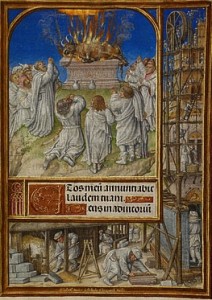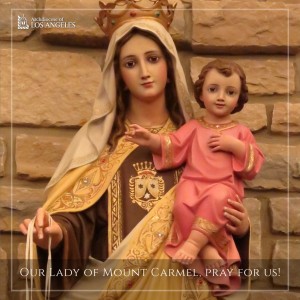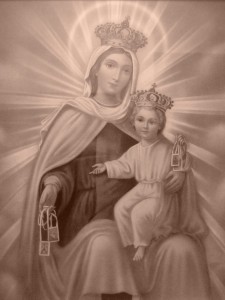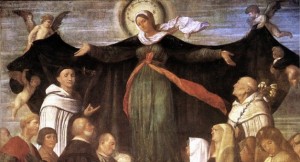“I am always thinking of you and helping you to secure Eternal Life.”
As Pope Pius XII wrote “Christ is the way; Mary reflects the way; her scapular is our keepsake on the way.”
“A man was rushed to a New York City hospital unconscious and dying. The nurse saw the man was wearing a brown scapular of a Our Lady of Mount Carmel and called for the priest. As the prayers were being said for the dying, the man became conscious. ‘Father, I am not a Catholic.’ The man said. The priest asked why he was wearing the scapular. ‘I promised friends I would wear it and say one Hail Mary each day.’ The priest asked the man if he wanted to baptized. The man desired his whole life to become Catholic. He was baptized and received the Last Rites and died in peace.”
Our Lady of Mount Carmel, pray for us!
 Saint John Paul II said in 2000: “As I look at these mountains, my thoughts turn today to Mount Carmel, praised in the Bible for its beauty. We are, in fact, celebrating the feast of Our Lady of Mount Carmel. On that mountain, located in Israel near Haifa, the holy prophet Elijah strenuously defended the integrity and purity of the chosen people’s faith in the living God. On that same mountain some hermits gathered in the 12th century after Christ and dedicated themselves to contemplation and penance. The Carmelite Order arose from their spiritual experience.
Saint John Paul II said in 2000: “As I look at these mountains, my thoughts turn today to Mount Carmel, praised in the Bible for its beauty. We are, in fact, celebrating the feast of Our Lady of Mount Carmel. On that mountain, located in Israel near Haifa, the holy prophet Elijah strenuously defended the integrity and purity of the chosen people’s faith in the living God. On that same mountain some hermits gathered in the 12th century after Christ and dedicated themselves to contemplation and penance. The Carmelite Order arose from their spiritual experience.
Walking with the Blessed Virgin, the model of complete fidelity to the Lord, we will fear no obstacles or difficulties.
Supported by her motherly intercession, like Elijah we will be able to fulfill our vocation as authentic “prophets” of the Gospel in our time… May Our Lady of Mount Carmel, whom we call upon today with special devotion, help us tirelessly climb towards the summit of the mountain of holiness; may she help us love nothing more than Christ, who reveals to the world the mystery of divine love and true human dignity.”
 O most beautiful flower of Mt. Carmel, fruitful vine, splendour of Heaven, Blessed Mother of the Son of God, Immaculate Virgin, assist me in my necessity. O Star of the Sea, help me and show me you are my Mother. O Holy Mary, Mother of God, Queen of Heaven and earth, I humbly beseech you from the bottom of my heart to succour me in this necessity (make request). There are none that can withstand your power. O Mary, conceived without sin, pray for us who have recourse to thee. Sweet Mother I place this cause in your hands. Amen.
O most beautiful flower of Mt. Carmel, fruitful vine, splendour of Heaven, Blessed Mother of the Son of God, Immaculate Virgin, assist me in my necessity. O Star of the Sea, help me and show me you are my Mother. O Holy Mary, Mother of God, Queen of Heaven and earth, I humbly beseech you from the bottom of my heart to succour me in this necessity (make request). There are none that can withstand your power. O Mary, conceived without sin, pray for us who have recourse to thee. Sweet Mother I place this cause in your hands. Amen.
Intimately connected with Our Lady of Mount Carmel is the Brown Scapular. Why not read a brief article on the scapular, a rather influential sacramental.
 Today, the Church honors the Mother of God under the title of Our Lady of Mount Carmel. This feast, historically, is clearly a feast recognizing Mary’s patronage of the Carmelite order. What does this feast say to us today? The Marian feast of Carmel is pointing us to Mary’s interior life, her life of prayer –her contemplation by holding all things concerning her Son in her heart. The Church gives witness that all Christians are called to pray and to enter into contemplation according to the grace given by God.
Today, the Church honors the Mother of God under the title of Our Lady of Mount Carmel. This feast, historically, is clearly a feast recognizing Mary’s patronage of the Carmelite order. What does this feast say to us today? The Marian feast of Carmel is pointing us to Mary’s interior life, her life of prayer –her contemplation by holding all things concerning her Son in her heart. The Church gives witness that all Christians are called to pray and to enter into contemplation according to the grace given by God.
Only later did the feast get connected with the giving of the brown scapular to Saint Simon Stock for the members of the order, and later to the laity. According to Stock’s vision of Mary, in use of the brown scapular Mary there’s the promise to the wearer that she will intercede with her Son to have mercy at the time of death. The scapular is the outward sign (a sacramental) of the consecration one makes to the Blessed Virgin who leads the person to the Savior.
The Congregation of Divine Worship (at the Holy See) said in 1996, “Devotion to Our Lady of Mount Carmel is bound to the history and spiritual values of the Order of the Brothers of the Blessed Virgin Mary of Mount Carmel and is expressed through the scapular. Thus, whoever receives the scapular becomes a member of the order and pledges him/herself to live according to its spirituality in accordance with the characteristics of his/her state in life.”
 Discalced Carmelite Father Kieran Kavanaugh, said,
Discalced Carmelite Father Kieran Kavanaugh, said,
“The scapular is a Marian habit or garment. It is both a sign and pledge. A sign of belonging to Mary; a pledge of her motherly protection, not only in this life but after death. As a sign, it is a conventional sign signifying three elements strictly joined: first, belonging to a religious family particularly devoted to Mary, especially dear to Mary, the Carmelite Order; second, consecration to Mary, devotion to and trust in her Immaculate Heart; third an incitement to become like Mary by imitating her virtues, above all her humility, chastity, and spirit of prayer.”
As you know, all Marian theology points to Christ. Key in historical theology is the work of Saint Leo the Great who does not speak to the feast of Our Lady of Mount Carmel but he does contexutalize our teaching on Mary’s role in salvation history by making the crucial criterion of understanding her role viz. giving the Eternal Word, the Savior of All, human personhood.
Saint Leo is credited with forming the dogma of the Incarnation and taught by the weight of the argument and only then by his office the teachings of the Council of Chalcedon regarding the person of Jesus Christ: that Jesus has two natures—divine and human—united in one person, “with neither confusion nor division,” known in technical theological language as the hypostatic union.
What follows is a portion of a sermon by Saint Leo the Great, a Roman pope who reigned from 440 to 461; his feast day is November 10; the first to be called “Great.” Mary points to Christ, our Savior!!!
Mary conceived in her soul before she conceived in her body
A royal virgin of the house of David is chosen. She is to bear a holy child, one who is both God and man. She is to conceive him in her soul before she conceives him in her body. In the face of so unheard of an event she is to know no fear through ignorance of the divine plan; the angel tells her what is to be accomplished in her by the Holy Spirit. She believes that there will be no loss of virginity, she who is soon to be the mother of God. Why should she lose heart at this new form of conceiving when she has been promised that it will be effected through the power of the Most High? She believes, and her faith is confirmed by the witness of a previous wonder: against all expectation Elizabeth is made fruitful. God has enabled a barren woman to be with child; he must be believed when he makes the same promise to a virgin.
The son of God who was in the beginning with God, through whom all things were made, without whom nothing was made, became man to free him from eternal death. He stooped down to take up our lowliness without loss to his own glory. He remained what he was; he took up what he was not. He wanted to join the very nature of a servant to that nature in which he is equal to God the Father. He wanted to unite both natures in an alliance so wonderful that the glory of the greater would not annihilate the lesser, nor the taking up of the lower diminish the greatness of the higher.
What belongs to each nature is preserved intact and meets the other in one person: lowliness is taken up by greatness, weakness by power, mortality by eternity. To pay the debt of our human condition, a nature incapable of suffering is united to a nature capable of suffering, and true God and true man are forged into the unity that is the Lord. This was done to make possible the kind of remedy that fitted our human need: one and the same mediator between God and men able to die because of one nature, able to rise again because of the other. It was fitting, therefore, that the birth which brings salvation brought no corruption to virginal integrity; the bringing forth of Truth was at the same time the safeguarding of virginity.
Dearly beloved, this kind of birth was fitting for Christ, the power and the wisdom of God: a birth in which he was one with us in our human nature but far above us in his divinity. If he were not true God, he would not be able to bring us healing; if he were not true man, he would not be able to give us an example.
And so at the birth of our Lord, the angels sing in joy: Glory to God in the highest, and they proclaim peace to his people on earth as they see the heavenly Jerusalem being built from all the nations of the world. If the angels on high are so exultant at this marvelous work of God’s goodness, what joy should it not bring to the lowly hearts of men?
(Sermo 1 in Nativitate Domini, 2.3: PL 54, 191-192)
I was asking myself why today’s feast of Our Lady of Mount Carmel is a universal feast of the Church. But, why, then, is the feast of Our Lady of the Rosary a widespread feast? Because of the popularity of the devotion is a good approximate answer. Go to Mary for help is a certain gesture of dependence.
The feast recalls a 1226 victory over enemies of the Church and the Carmelite friars, and it also recalls the reception of the scapular by Saint Simon Stock on this date in 1251.
By the 14th century the proposed feast received approval of the Roman Pontiffs Honorius III and later by Sixtus V; over the years it has been questioned by ecclesiastical figures and found to be appropriate for the Carmelite order with a proper vigil Mass and a privileged octave.
Our Lady of Mount Carmel’s feast is another feast of the Virgin Mary that focuses our eyes on the Lord. And, we can never have a enough of that.
You may be interested in reading this piece on scapulars.
May the venerable intercession of the glorious Virgin Mary come to our aid, we pray, O Lord, so that, fortified by her protection, we may reach the mountain which is Christ.
Our Lady of Mount Carmel, pray for us.
The Blessed Virgin Mary never fails. She always kept her promise; always go to Mary. Saint Simon Stock the English Carmelite friar received this promise from the Virgin herself and he passed it on to the Church.
The Virgin Mary gave to Saint Simon the brown scapular, saying “Take this Scapular, it shall be a sign of salvation, protection in danger and a pledge of peace. Whosoever dies wearing this scapular shall not suffer eternal fire.” The soul wearing the scapular would be in heaven on the first Saturday of the month following death.
Thus, wearing the brown scapular is not required; it is a helpful sacramental to remind us that we are not alone and that God through Mary’s assistance keeps us close to the Mystery. Originally only worn by those of the Carmelite Order, it was soon adopted by the lay faithful. To this day, the brown scapular, is one of the most popular of all Catholic sacramentals.